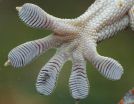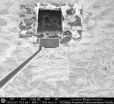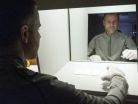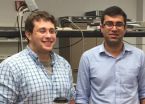(Press-News.org) Durham, NC — Ancient DNA adds a twist to the story of how barnyard chickens came to be, finds a study to be published April 21 in the journal Proceedings of the National Academy of Sciences.
Analyzing DNA from the bones of chickens that lived 200-2300 years ago in Europe, researchers report that just a few hundred years ago domestic chickens may have looked far different from the chickens we know today.
The results suggest that some of the traits we associate with modern domestic chickens -- such as their yellowish skin -- only became widespread in the last 500 years, much more recently than previously thought.
"It's a blink of an eye from an evolutionary perspective," said co-author Greger Larson at Durham University in the United Kingdom.
The study is part of a larger field of research that aims to understand when, where and how humans turned wild plants and animals into the crops, pets and livestock we know today.
Generally, any mutations that are widespread in domestic plants and animals but absent from their wild relatives are assumed to have played a key role in the process, spreading as people and their livestock moved across the globe. But a growing number of ancient DNA studies tell a different tale.
Chickens are descended from a wild bird called the Red Junglefowl that humans started raising roughly 4,000-5,000 years ago in South Asia. To pinpoint the genetic changes that transformed this shy, wild bird into the chickens we know today, researchers analyzed DNA from the skeletal remains of 81 chickens retrieved from a dozen archeological sites across Europe dating from 200 to 2,300 years old.
The researchers focused on two genes known to differ between domestic chickens and their wild counterparts: a gene associated with yellow skin color, called BCDO2, and a gene involved in thyroid hormone production, called TSHR.
Though the exact function of TSHR is unknown, it may be linked to the domestic chicken's ability to lay eggs year-round – a trait that Red Junglefowl and other wild birds don't have.
When the team compared the ancient sequences to the DNA of modern chickens, only one of the ancient chickens had the yellow skin so common in chickens today. Similarly, less than half of the ancient chickens had the version of the TSHR gene found worldwide in modern chickens.
The results suggest that these traits only became widespread within the last 500 years -- thousands of years after the first barnyard chickens came to be. "Just because a plant or animal trait is common today doesn't mean that it was bred into them from the beginning," Larson said.
"It demonstrates that the pets and livestock we know today -- dogs, chickens, horses, cows -- are probably radically different from the ones our great-great-grandparents knew," he added.
"…They are subjected to the whim of human fancy and control, [so] radical change in the way they look can be achieved in very few generations."
The study is part of a collection of articles in a special edition of PNAS devoted to domestication. This study and others featured in the special issue stemmed from a meeting that took place in 2011 at the National Evolutionary Synthesis Center in Durham, North Carolina. Learn more about the meeting – titled "Domestication as an Evolutionary Phenomenon: Expanding the Synthesis" -- at http://domestication.groupsite.com/main/summary.
INFORMATION:
Other authors of the study include Linus Flink, Richard Allen and Ross Barnett of Durham University; Helena Malmström, Jonas Eriksson and Leif Andersson of Uppsala University in Sweden; Joris Peters of Ludwig Maximilian University in Munich, and Keith Dobney of the University of Aberdeen in Scotland.
CITATION: Flink, L., et al. (2014). "Establishing the validity of domestication genes using DNA from ancient chickens." PNAS.
The National Evolutionary Synthesis Center (NESCent) is a nonprofit science center dedicated to cross-disciplinary research in evolution. Funded by the National Science Foundation, NESCent is jointly operated by Duke University, The University of North Carolina at Chapel Hill, and North Carolina State University. For more information about research and training opportunities at NESCent, visit http://www.nescent.org.
Ancient DNA offers clues to how barnyard chickens came to be
Chickens living just a few hundred years ago may have looked far different from the chickens of today
2014-04-18
ELSE PRESS RELEASES FROM THIS DATE:
Plants with dormant seeds give rise to more species
2014-04-18
Durham, NC — Seeds that sprout as soon as they're planted may be good news for a garden. But wild plants need to be more careful. In the wild, a plant whose seeds sprouted at the first
warm spell or rainy day would risk disaster. More than just an insurance policy against late frosts or unexpected dry spells, it turns out that seed dormancy has long-term advantages too: Plants whose seeds put off sprouting until conditions are more certain give rise to more species, finds in a team of researchers working at the National Evolutionary Synthesis Center in North Carolina.
When ...
Gecko-like adhesives now useful for real world surfaces
2014-04-18
AMHERST, Mass. – The ability to stick objects to a wide range of surfaces such as drywall, wood, metal and glass with a single adhesive has been the elusive goal of many research teams across the world, but now a team of University of Massachusetts Amherst inventors describe a new, more versatile version of their invention, Geckskin, that can adhere strongly to a wider range of surfaces, yet releases easily, like a gecko's feet.
"Imagine sticking your tablet on a wall to watch your favorite movie and then moving it to a new location when you want, without the need for ...
'Exotic' material is like a switch when super thin
2014-04-18
ITHACA, N.Y. – Researchers from Cornell University and Brookhaven National Laboratory have shown how to switch a particular transition metal oxide, a lanthanum nickelate (LaNiO3), from a metal to an insulator by making the material less than a nanometer thick.
Ever-shrinking electronic devices could get down to atomic dimensions with the help of transition metal oxides, a class of materials that seems to have it all: superconductivity, magnetoresistance and other exotic properties. These possibilities have scientists excited to understand everything about these materials, ...
New study suggests a better way to deal with bad memories
2014-04-18
What's one of your worst memories? How did it make you feel? According to psychologists, remembering the emotions felt during a negative personal experience, such as how sad you were or how embarrassed you felt, can lead to emotional distress, especially when you can't stop thinking about it.
When these negative memories creep up, thinking about the context of the memories, rather than how you felt, is a relatively easy and effective way to alleviate the negative effects of these memories, a new study suggests.
Researchers at the Beckman Institute at the University ...
Impurity size affects performance of emerging superconductive material
2014-04-18
Research from North Carolina State University finds that impurities can hurt performance – or possibly provide benefits – in a key superconductive material that is expected to find use in a host of applications, including future particle colliders. The size of the impurities determines whether they help or hinder the material's performance.
At issue is a superconductive material called bismuth strontium calcium copper oxide (Bi2212). A superconductor is a material that can carry electricity without any loss – none of the energy is dissipated as heat, for example. Superconductive ...
Innovative strategy to facilitate organ repair
2014-04-18
This news release is available in French. A significant breakthrough could revolutionize surgical practice and regenerative medicine. A team led by Ludwik Leibler from the Laboratoire Matière Molle et Chimie (CNRS/ESPCI Paris Tech) and Didier Letourneur from the Laboratoire Recherche Vasculaire Translationnelle (INSERM/Universités Paris Diderot and Paris 13), has just demonstrated that the principle of adhesion by aqueous solutions of nanoparticles can be used in vivo to repair soft-tissue organs and tissues. This easy-to-use gluing method has been tested on rats. When ...
Under some LED bulbs whites aren't 'whiter than white'
2014-04-18
For years, companies have been adding whiteners to laundry detergent, paints, plastics, paper and fabrics to make whites look "whiter than white," but now, with a switch away from incandescent and fluorescent lighting, different degrees of whites may all look the same, according to experts in lighting.
"Retailers have long been concerned with the color-rendering qualities of their lighting, but less aware how light sources render white," said Kevin W. Houser, professor of architectural engineering, Penn State.
Not long ago, the only practical choices for home, office ...
Frozen in time: 3-million-year-old landscape still exists beneath the Greenland ice sheet
2014-04-18
Some of the landscape underlying the massive Greenland ice sheet may have been undisturbed for almost 3 million years, ever since the island became completely ice-covered, according to researchers funded by the National Science Foundation (NSF).
Basing their discovery on an analysis of the chemical composition of silts recovered from the bottom of an ice core more than 3,000 meters long, the researchers argue that the find suggests "pre-glacial landscapes can remain preserved for long periods under continental ice sheets."
In the time since the ice sheet formed "the ...
Impact glass stores biodata for millions of years
2014-04-18
PROVIDENCE, R.I. [Brown University] — Asteroid and comet impacts can cause widespread ecological havoc, killing off plants and animals on regional or even global scales. But new research from Brown University shows that impacts can also preserve the signatures of ancient life at the time of an impact.
A research team led by Brown geologist Pete Schultz has found fragments of leaves and preserved organic compounds lodged inside glass created by a several ancient impacts in Argentina. The material could provide a snapshot of environmental conditions at the time of those ...
'Dressed' laser aimed at clouds may be key to inducing rain, lightning
2014-04-18
The adage "Everyone complains about the weather but nobody does anything about it," may one day be obsolete if researchers at the University of Central Florida's College of Optics & Photonics and the University of Arizona further develop a new technique to aim a high-energy laser beam into clouds to make it rain or trigger lightning.
The solution? Surround the beam with a second beam to act as an energy reservoir, sustaining the central beam to greater distances than previously possible. The secondary "dress" beam refuels and helps prevent the dissipation of the high-intensity ...
LAST 30 PRESS RELEASES:
Myeloma: How AI is redrawing the map of cancer care
Manhattan E. Charurat, Ph.D., MHS invested as the Homer and Martha Gudelsky Distinguished Professor in Medicine at the University of Maryland School of Medicine
Insilico Medicine’s Pharma.AI Q4 Winter Launch Recap: Revolutionizing drug discovery with cutting-edge AI innovations, accelerating the path to pharmaceutical superintelligence
Nanoplastics have diet-dependent impacts on digestive system health
Brain neuron death occurs throughout life and increases with age, a natural human protein drug may halt neuron death in Alzheimer’s disease
SPIE and CLP announce the recipients of the 2025 Advanced Photonics Young Innovator Award
Lessons from the Caldor Fire’s Christmas Valley ‘Miracle’
Ant societies rose by trading individual protection for collective power
Research reveals how ancient viral DNA shapes early embryonic development
A molecular gatekeeper that controls protein synthesis
New ‘cloaking device’ concept to shield sensitive tech from magnetic fields
Researchers show impact of mountain building and climate change on alpine biodiversity
Study models the transition from Neanderthals to modern humans in Europe
University of Phoenix College of Doctoral Studies releases white paper on AI-driven skilling to reduce burnout and restore worker autonomy
AIs fail at the game of visual “telephone”
The levers for a sustainable food system
Potential changes in US homelessness by ending federal support for housing first programs
Vulnerability of large language models to prompt injection when providing medical advice
Researchers develop new system for high-energy-density, long-life, multi-electron transfer bromine-based flow batteries
Ending federal support for housing first programs could increase U.S. homelessness by 5% in one year, new JAMA study finds
New research uncovers molecular ‘safety switch’ shielding cancers from immune attack
Bacteria resisting viral infection can still sink carbon to ocean floor
Younger biological age may increase depression risk in older women during COVID-19
Bharat Innovates 2026 National Basecamp Showcases India’s Most Promising Deep-Tech Ventures
Here’s what determines whether your income level rises or falls
SCIE indexation achievement: Celebrate with Space: Science & Technology
Children’s Hospital Colorado performs region’s first pediatric heart and liver dual organ transplant
Australian team discover why quantum computers have memory problems over time
What determines the fate of a T cell?
Candida auris: genetic process revealed which could be treatment target for deadly fungal disease
[Press-News.org] Ancient DNA offers clues to how barnyard chickens came to beChickens living just a few hundred years ago may have looked far different from the chickens of today







